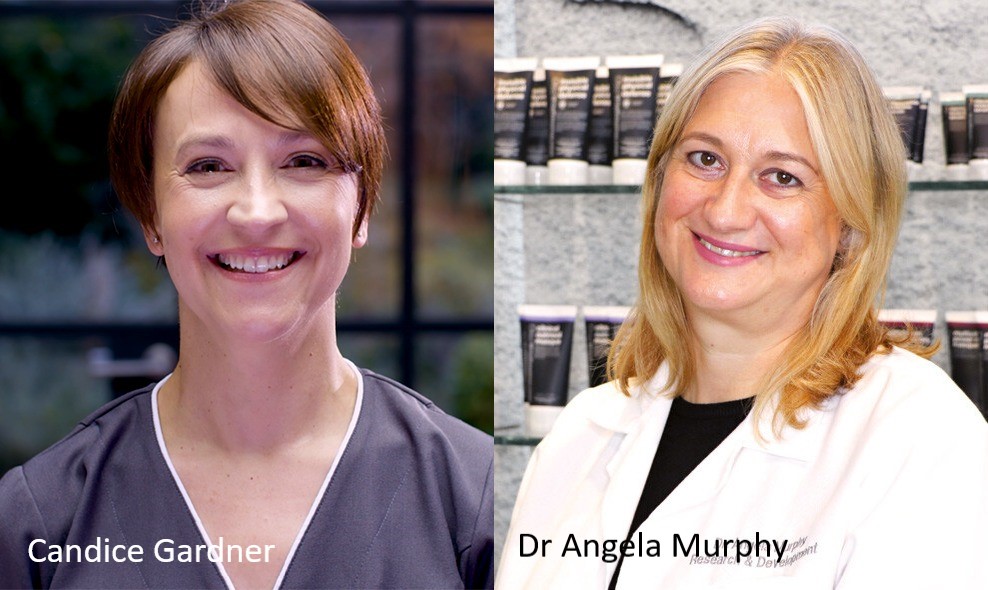ABT Meets: Dermalogica reveal the latest micro injury treatments
In an exciting development, professional skin care brand Dermalogica has launched their Advanced Treatments into the UK and Ireland, including micro injury anti-ageing therapies.
 We met with Dr Angela Murphy, Vice President of Research and Development at Dermalogica, and Candice Gardner, Education manager for Learning and Content for Dermalogica UK and Ireland, for an exclusive chat about their new treatment launches and how they can be incorporated into your salon treatment menu.
We met with Dr Angela Murphy, Vice President of Research and Development at Dermalogica, and Candice Gardner, Education manager for Learning and Content for Dermalogica UK and Ireland, for an exclusive chat about their new treatment launches and how they can be incorporated into your salon treatment menu.
Why is Dermalogica launching advanced treatments?
Candice Gardner: There is a real desire for high-impact treatments that get a very fast result, and so we're seeing a movement from traditional manual based treatment to be able to leverage technology in services, advanced product formulations, and really push the boundaries on changing skin and skin health and how we get there with the treatments that are available. So our newer treatments are designed to help customers on that journey but meet them where they are on their own personal skincare journey.
What types of treatments are you launching and what results can be expected?
CG: We're looking to launch a number of different treatments that leverage technology and also leverage product. Our Pro NanoInfusion service really helps to resurface the skin, to refine textural issues in the skin, to boost luminosity and brightness. It's a fantastic treatment that really energises the skin and gives the skin a fantastic glow.
We also are introducing Pro NanoInfusion is a micro injury service, and what is probably unique about Dermalogica's Pro NanoInfusion service is that it also combines the use of peels, and that's a key consumer desire and trend to combine different treatments to help amplify results.
Pro NanoInfusion is micro injury which is all centered around wound healing, and those types of treatments are really excellent for helping to rejuvenate skin, restructure skin, so brilliant for things like firming, also helping to address pigmentation changes in the skin, things like pores as well. There is a textural change on the skin but from a deeper level…this really helps things like lines and wrinkles and ageing concerns and skin strength.
How do these types of treatments affect the skin?
CG: Probably what's most significant about a service like Pro NanoInfusion is we're using a wound healing process, we're stimulating a controlled inflammation of the skin, and we're creating a micro injury that triggers the skin's natural regenerative process. The benefits that we get are the result of the skin trying to repair itself post that wound.
Micro injury services are very effective in helping to stimulate collagen production, to rebuild tissue, and stimulate the skin renewal process. But because we're injuring the skin, we have to do that in a measured and controlled fashion. We have to be very conscious of what we do before the treatment to prepare the skin to be able to accept that treatment. We need to think about what we're doing during the treatment, and then we need to think about how we look after the skin after the treatment so that it recovers well and we see the outcomes that we want to see.
How have these advanced services informed your Research & Development (R&D) strategy?
Dr Angela Murphy: When we're creating any product, we really want to think hard about what's happening in the skin before we even start formulating. The micro injury treatments are inducing a controlled injury in order to trigger the skin to recover and then ultimately improve the appearance of the skin. So what we want to do is think about that whole process and the whole wound healing cycle when we're thinking about products that could work alongside those sorts of services.
One of the key principles that we have been thinking about is the concept of pro-resolution so what you're doing is triggering inflammation in the skin, and ultimately as a result of the inflammation and its processes and the skin regenerates itself. Now often when we get inflammation in the skin we just want it to go away but it isn't want we want to do here. What we actually need to do is drive the inflammation forward to full completion, because it's only when you get that full completion that you trigger all of the processes to regenerate the skin and also to remove debris in the optimal way to get the best end results. So that has been a key principle that we have thought about in creating our products in this context.
 Is there something new on the horizon for Dermalogica in this arena?
Is there something new on the horizon for Dermalogica in this arena?
AM: We have actually created a new product called Dermalogica Pro Restore, which is super exciting, which has been developed specifically for use with any micro injury treatment and central to this is the concept of pro resolution.
We've designed this product to decrease downtime, improve skin recovery and it's probably not surprising that if you get that right, you're going to improve the end benefits as well. It is a recovery and firming concentrate and it comes in little ampoules.
We basically designed the product in three phases: the first phase is all about preparing the skin for the treatment so what we're trying to do is strengthen the skin and to minimise inflammation discomfort. We're using Panthenol, vitamin B5, to help strengthen the skin and we also have a mushroom extract in there which helps with pain receptors so you feel things a little less.
The next key function of the product is the regenerative phase, where we're trying to support optimal peeling and tissue regeneration, and this where the Pro Resolution is really, really important. Our key active for the Pro Resolution is Omega 3; we've found that is a brilliant active for driving the inflammation forward to full completion which is exactly what we want. We've also included Bacillus Ferment in there to balance the microbiome. We're learning a lot more about how important the microbiome is for skin health and doing something like [micro injury] will obviously unbalance the microbiome so we want to get it back into a good state of balance as soon as we can. And then finally we have Beta Glucan to accelerate mood closure and cellular turnover.
And then the third key functionality of the product is amplifying end results. Already you're going to get an amplification of the end results from managing this inflammation resolution process properly but we've also got in some ingredients over and above that to further support it. We have Peptides, we have Niacinamide and we have some olive stem cells, they're helping [with] collagen production, and the stem cells in particular help to increase cellular energy which just makes everything work a lot better.
As well as being one of the first products to address the complete wound healing cycle, this is one of the first products to be used in the treatment room and at home. One ampoule is used by the therapist during the treatment and the consumer is given two to take home and they continue to use it for seven days after the treatment. And that helps to achieve our goal of being involved in the whole wound healing recovery cycle.
How do Dermalogica's micro injury treatments differ to those currently on the market?
CG: I think probably one of the core differences with Dermalogica's micro injury treatments is that firstly we use a lot of combined services, so in other words we combine the use of chemical peels with our micro needling for example, that we're able to reamplify the results for the client.
Secondly, we have a really considered methodology around our technique. We chose to use a micro needling pen and that gives us greater control in terms of how we can work across the skin. It also helps us manage efficiency in the service because that's also important; the service needs to be efficient in order to deliver it well and to be able to amplify the parts of the service that need maximum time.
The third thing is Pro Restore; it's a game changer in terms of the skin's recovery and repair process. From a client perspective, in terms of the comfort level of the service, it makes a real difference because a lot of controlled inflammation and micro injury services are not particularly comfortable post-service.
How often would a client have a Dermalogica advanced treatment such as this?
CG: Most micro injury services are done at monthly intervals, that's really important because what we want to try and do is ensure the wound healing process has completely finished before you start the next service. Otherwise, what we could do is initiate an uncontrolled inflammatory situation and it'll be more difficult to manage that inflammation in the skin because the skin is not quite ready at that point.
It depends on the individual as to whether that's a programme or a course of treatments; it's relatively rare to have one treatment as normally you're targeting a specific skin issue or concern in three to six treatments at monthly intervals.
How are you training therapists to carry out these new treatments?
CG: The Dermalogica programme for our advanced services includes a series of e-learning modules to start with, they take roughly around six hours to complete. That is accompanied by a practical hands-on day where we can focus purely on the service strategy and the decision making that needs to happen during the treatment. You get the chance to give and receive a treatment so that you can really understand and dissect that treatment and feel to be able to execute it.
Dermalogica
0800 917 7147
Updated 3.4.23








